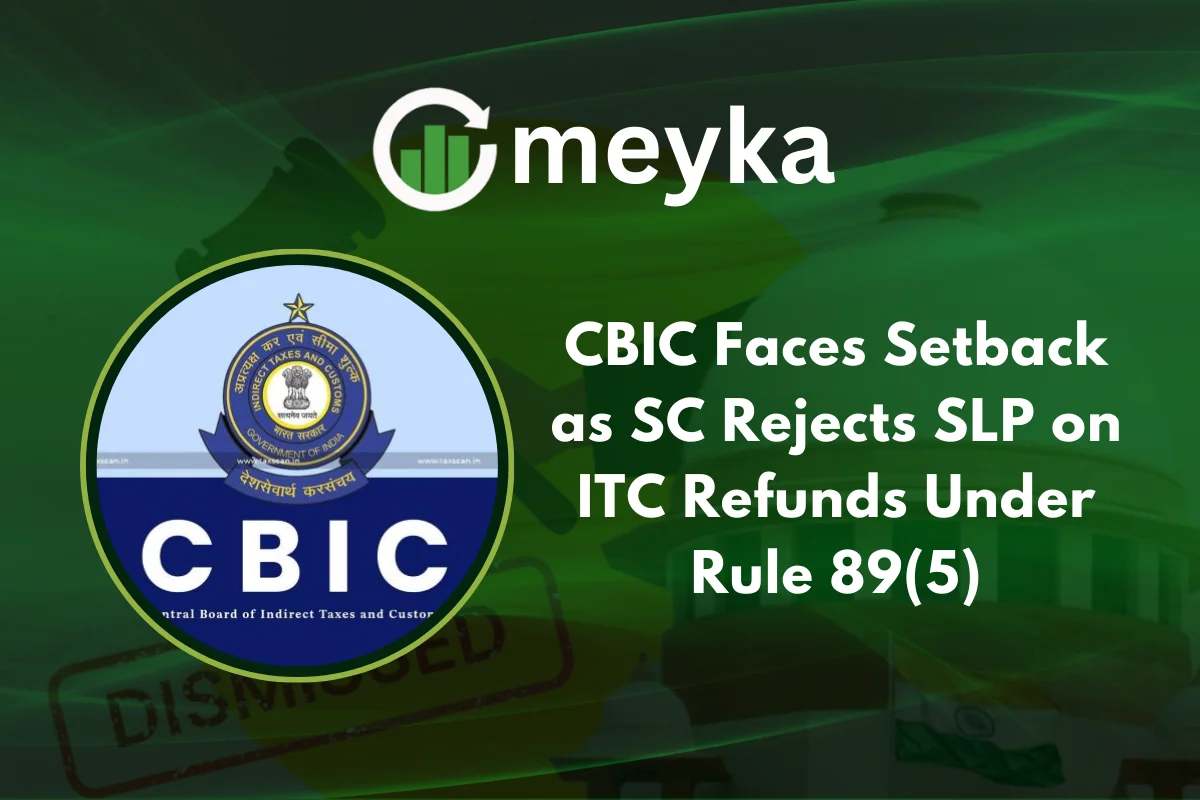CBIC Faces Setback as SC Rejects SLP on ITC Refunds Under Rule 89(5)
The Central Board of Indirect Taxes and Customs (CBIC) has faced a significant legal challenge after the Supreme Court of India (SC) rejected its Special Leave Petition (SLP) regarding the interpretation of Rule 89(5) of the Central Goods and Services Tax (CGST) Rules. This ruling has reignited debates on the scope of Input Tax Credit (ITC) refunds, particularly for industries that rely heavily on inverted duty structures.
Understanding Rule 89(5) and the ITC Refund Dispute
Rule 89(5) of the CGST Rules governs the refund of unutilized ITC in cases of inverted duty structure, a scenario where the rate of tax on inputs is higher than the rate of tax on output supplies.
For example, if a manufacturer pays 18% GST on raw materials but sells the finished goods at 12% GST, excess ITC accumulates. Businesses naturally seek a refund of this excess ITC to maintain liquidity.
However, Rule 89(5) has been contentious because it restricts refunds to input goods only while excluding input services. This limitation was challenged in several High Courts, leading to different interpretations.
Supreme Court’s Decision on CBIC’s SLP
The CBIC filed an SLP before the Supreme Court, seeking clarity and reversal of High Court rulings that allowed refunds on both input goods and input services.
The Supreme Court, however, dismissed the SLP, effectively upholding the position that taxpayers can claim refunds beyond just input goods. This rejection is being viewed as a major setback for CBIC’s stance on restricting ITC refunds.
The decision strengthens the taxpayer’s claim to a broader interpretation of ITC refunds, ensuring that businesses burdened by inverted duty structures can now access more liquidity.
Impact of the Ruling on Businesses
Boost to Liquidity in Manufacturing and Exports
Industries such as textiles, footwear, and pharmaceuticals, which often face inverted duty structures, will benefit significantly. The inclusion of input services in refund eligibility ensures that businesses will not have their working capital locked unnecessarily.
Clarification of Ambiguity
For years, taxpayers faced uncertainty regarding refund eligibility under Rule 89(5). This ruling removes confusion and provides businesses with a more stable tax compliance framework.
Increased Compliance Pressure on CBIC
While the decision benefits businesses, it places added responsibility on CBIC to revise its refund mechanisms, streamline processes, and address the larger fiscal implications. The government may also need to amend the GST law to align with this interpretation.
CBIC’s Stand and Future Course of Action
The CBIC has long argued that including input services in refunds would lead to revenue leakage. According to its position, GST was designed with a specific refund structure to balance government revenue and taxpayer relief.
With the Supreme Court rejecting its plea, CBIC may now look toward:
- Proposing amendments to the GST law through the GST Council.
- Issuing fresh clarifications or circulars to redefine refund eligibility.
- Exploring policy changes that minimize revenue loss while supporting business liquidity.
For taxpayers, this decision signals a shift toward greater fairness and recognition of operational challenges under GST.
Legal and Economic Significance of the Ruling
The Supreme Court’s rejection of CBIC’s SLP carries broader implications:
- Judicial Precedence: High Court rulings favoring taxpayers gain more weight, guiding future litigation.
- Economic Relief: Businesses suffering from rising input costs get much-needed cash flow support.
- Policy Adjustments: The government must strike a balance between reducing the fiscal deficit and improving the ease of doing business.
In the context of India’s economic growth, particularly amid global uncertainties, the decision supports exporters and domestic manufacturers by strengthening their competitiveness.
Expert Opinions on the Verdict
Tax experts and industry analysts have largely welcomed the ruling. Professionals argue that excluding input services created an artificial and unfair distinction.
Others note that while the decision provides short-term relief, the GST Council may soon revisit the law to prevent large-scale revenue loss. This could mean potential amendments in the upcoming sessions.
How Businesses Should Respond
Businesses should adopt a proactive approach in light of the ruling:
- File Refund Claims Promptly: Taxpayers should take advantage of the expanded scope and submit refund applications without delay.
- Maintain Strong Documentation: Ensuring accurate invoices and ITC records will help avoid disputes during audits.
- Seek Professional Guidance: Engaging tax consultants will be essential to maximize benefits while ensuring compliance with evolving rules.
Broader Implications for the Stock Market and Investment Climate
Although this ruling directly concerns taxation, its ripple effects touch the stock market and investment landscape. Enhanced liquidity for businesses translates into improved profitability, which can positively influence stock research and investor confidence.
Investors tracking manufacturing and export-heavy sectors may find this ruling supportive of growth, with potential stock price appreciation in the medium term. While this does not directly affect AI stocks or technology-driven companies, the broader positive sentiment in the market strengthens India’s investment outlook.
Conclusion
The Supreme Court’s rejection of the CBIC’s SLP under Rule 89(5) is a landmark moment in India’s GST journey. It strengthens taxpayer rights, provides relief to industries struggling with inverted duty structures, and highlights the importance of balanced policymaking.
For the CBIC, this is a wake-up call to revisit its stance and work toward a refund system that supports both business growth and government revenue needs. For businesses, it is an opportunity to reclaim liquidity and strengthen operations.
The ruling not only reshapes the future of ITC refunds but also reflects the maturing nature of India’s GST regime, toward greater clarity, fairness, and economic resilience.
FAQs
Rule 89(5) deals with refunds of unutilized Input Tax Credit in cases of inverted duty structures, where input taxes are higher than output taxes.
The Court rejected CBIC’s plea to restrict refunds to input goods, supporting a broader interpretation that allows refunds on both input goods and services.
Businesses, especially in sectors with inverted duty structures, will have better liquidity and reduced working capital stress due to wider refund eligibility.
Disclaimer:
This content is made for learning only. It is not meant to give financial advice. Always check the facts yourself. Financial decisions need detailed research.






